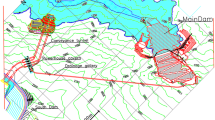Abstract
The predicted relationship between water table rise and time behind a constructed underground dam is established in this paper based on a semi-physically based approach. This approach utilizes values of the most effective actual groundwater aquifer properties. Robustness of this approach was tested by applying it to a number of proposed underground dam sites in two real aquifers, in addition to a number of hypothetical cases. Results were compared with MODFLOW simulation outputs for these cases, and the comparison is found to be very encouraging.















Similar content being viewed by others
References
Ertsen M, Hut R (2009) Two waterfalls do not hear each other: sand-storage dams, science and sustainable development in Kenya. Phys Chem Earth 34:14–22
Hanson G, Nilsson A (1986) Ground-water dams for rural-water supplies in developing countries. Ground Water 24(4):497–506
Ishida S, Tsuchihara T, Imaizumi M (2006) Fluctuation of NO3–N in groundwater of the reservoir of the Sunagawa Subsurface Dam, Miyako Island, Japan. Paddy Water Environ 4(2):101–110
Janardhana RN, Reddy TVK, Munirathnam P (2006) Subsurface dams to harvest rainwater—a case study of the Swarnamukhi River Basin, Southern India. Hydrogeol J 14(4):526–531
Luyun R Jr, Momii K, Nakagawa K, Fujiyama S (2007) Saltwater dynamics due to cut-off wall installation in coastal unconfined aquifers: experimental and numerical studies, 2008. Proceedings of an International Conference on Calibration and Reliability in Groundwater Modelling: Credibility of Modeling, Vol. 320. Copenhagen, Denmark, 9–13 September 2007, pp 214–219
McDonald MG, AW Harbaugh, BR Orr, DJ Ackerman (1984) The U.S. Geological Survey modular finite difference groundwater flow model. U.S. Geological Survey, Open File Report, Virginia
Nilsson A (1988) Groundwater dams for small-scale water supply. IT Publications, London
Nishigaki M, Kankam-Yeboah KM (2004) Underground dam technology in some parts of the world. J Groundwater Hydrol 46(2):113–130
Onder H, Yilmaz M (2005) Underground dams. A tool of sustainable development and management of groundwater resources 11(12):35–45
Van Haveren BP (2004) Dependable water supplies from valley alluvium in arid regions. Environ Monit Assess 99:259–266
Waterloo Hydrogeologic Inc. (2005) Visual MODFLOW premium edition, user’s manual, v. 4.1, p 611
Acknowledgment
The author would like to express his sincere thanks to the Faculty of Earth Sciences at King Abdulaziz University for providing logistic support for the fieldwork. Also, special gratitude is articulated to Dr. M. Al-Ahmadi and Dr. N. Al-Amri for their help and support in the fieldwork carried out in Wadi Rabigh.
Author information
Authors and Affiliations
Corresponding author
Rights and permissions
About this article
Cite this article
El-Hames, A.S. Determination of the transient water table rise behind constructed underground dams. Arab J Geosci 5, 1359–1366 (2012). https://doi.org/10.1007/s12517-011-0299-2
Received:
Accepted:
Published:
Issue Date:
DOI: https://doi.org/10.1007/s12517-011-0299-2




